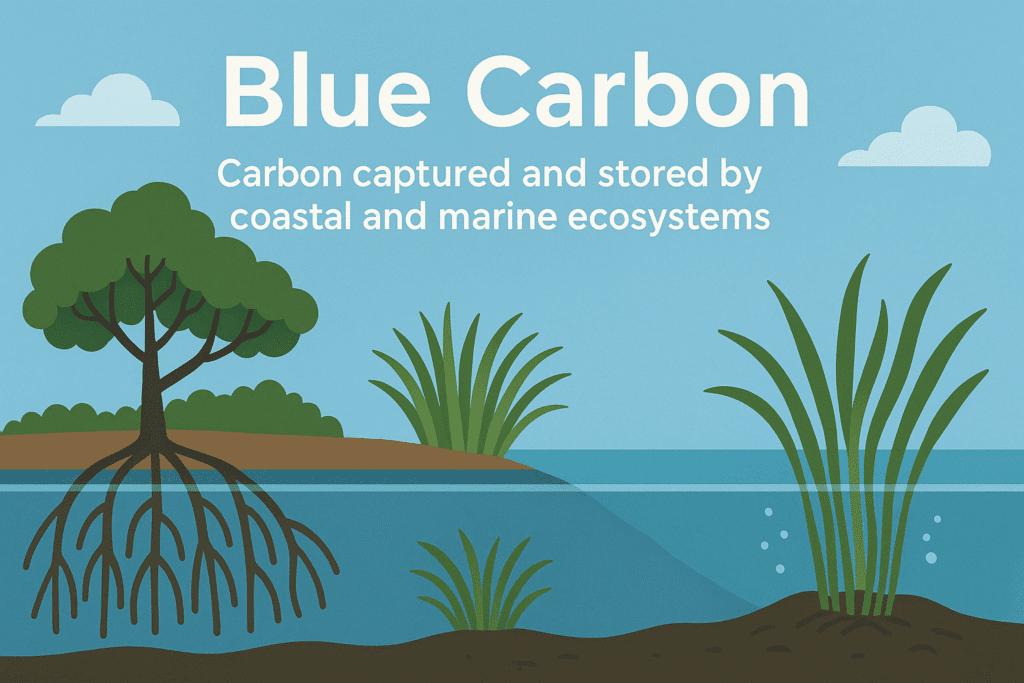When we talk about climate change, forests and renewable energy often take center stage. Yet, there exists a powerful, often overlooked natural solution that lies beneath the waves—blue carbon. This term refers to the carbon captured and stored by coastal and marine ecosystems such as mangroves, salt marshes, and seagrasses. These ecosystems are among the planet’s most efficient natural carbon sinks, quietly working to stabilize our climate while providing a host of ecological benefits.
What is Blue Carbon?
Blue carbon is the carbon dioxide captured from the atmosphere by coastal and marine plants and stored in biomass (roots, leaves, stems) and sediments. Unlike terrestrial forests, where carbon storage can be disrupted by fires or land-use change, blue carbon ecosystems store carbon in waterlogged soils, where it can remain locked away for thousands of years.
The Power of Coastal Ecosystems
- Mangroves: These salt-tolerant trees thrive along tropical coastlines. Not only do they absorb carbon dioxide at rates up to four times higher than rainforests, but their complex root systems also trap sediments, protecting shorelines from erosion.
- Seagrasses: Found in shallow waters, seagrass meadows absorb carbon both from the atmosphere and dissolved in ocean water, improving water quality and supporting marine biodiversity.
- Salt Marshes: These tidal wetlands act as buffers against storm surges while sequestering large amounts of carbon beneath their muddy soils.
Together, these ecosystems cover less than 2% of ocean area but are responsible for capturing more than half of all carbon stored in ocean sediments.
Why Does Blue Carbon Matter?
The importance of blue carbon extends far beyond carbon storage:
- Climate Mitigation: Healthy coastal ecosystems capture and lock away carbon, reducing greenhouse gases in the atmosphere.
- Biodiversity Hotspots: They provide nursery grounds for fish, crustaceans, and countless marine species.
- Coastal Protection: Mangroves and salt marshes act as natural barriers against cyclones, storms, and rising sea levels.
- Livelihoods: Millions of coastal communities rely on these ecosystems for fisheries, tourism, and cultural value.
Threats to Blue Carbon Ecosystems
Despite their importance, blue carbon ecosystems are under severe threat from coastal development, aquaculture, pollution, and climate change. Alarmingly, scientists estimate that we lose 1-2% of mangroves, salt marshes, and seagrasses every year. When these ecosystems are destroyed, not only do they stop capturing carbon, but the vast amounts stored in their soils are released back into the atmosphere—intensifying global warming.
Unlocking the Potential of Blue Carbon
Preserving and restoring blue carbon ecosystems can be a game-changer in the global climate fight. Governments, NGOs, and private companies are increasingly turning to blue carbon credits—financial mechanisms that reward the conservation of these ecosystems by valuing their carbon storage capacity. Such projects not only contribute to climate goals but also empower local communities by creating sustainable livelihoods.
A Path Forward
To harness the full potential of blue carbon, we must:
- Protect existing ecosystems through strong conservation policies.
- Restore degraded areas by replanting mangroves and rehabilitating coastal wetlands.
- Integrate blue carbon into climate strategies, ensuring it is recognized in carbon markets and global frameworks.
- Engage local communities, whose traditional knowledge and stewardship are vital for success.
Final Thoughts
Blue carbon is more than a scientific concept—it’s a lifeline for our planet and its people. By valuing and protecting these ecosystems, we can tackle climate change, protect biodiversity, and secure resilient coastlines for future generations. In the fight against global warming, perhaps the most powerful allies are hidden beneath the tides.

